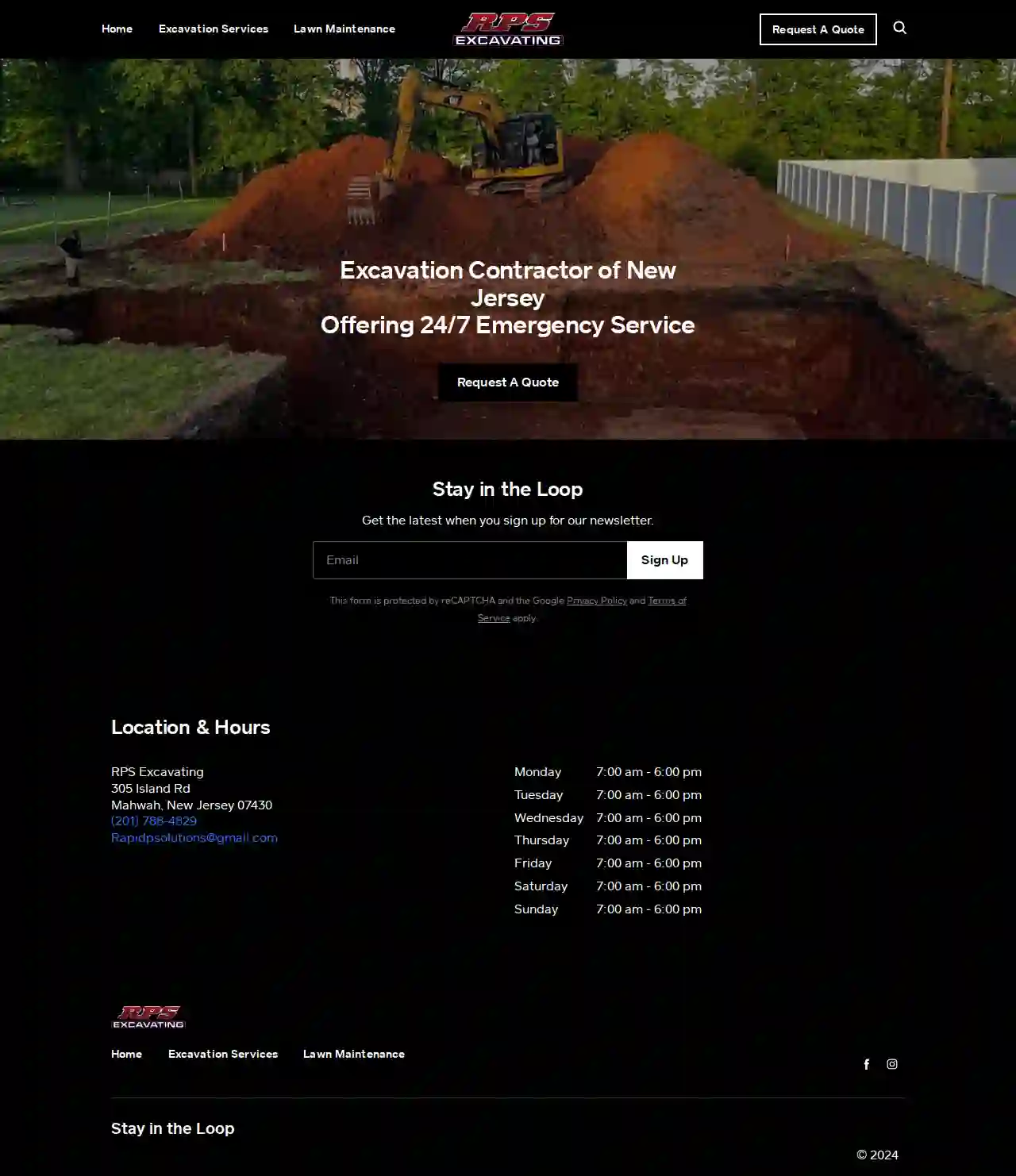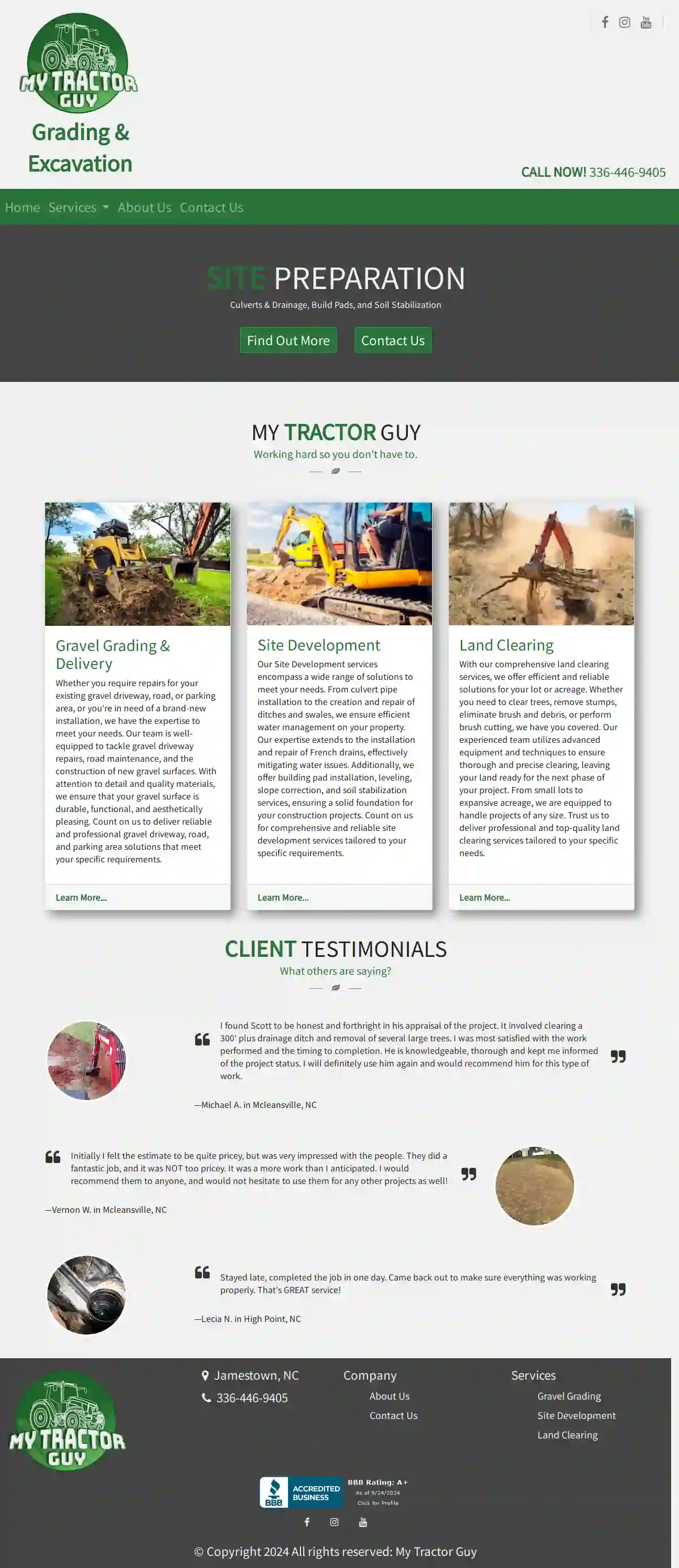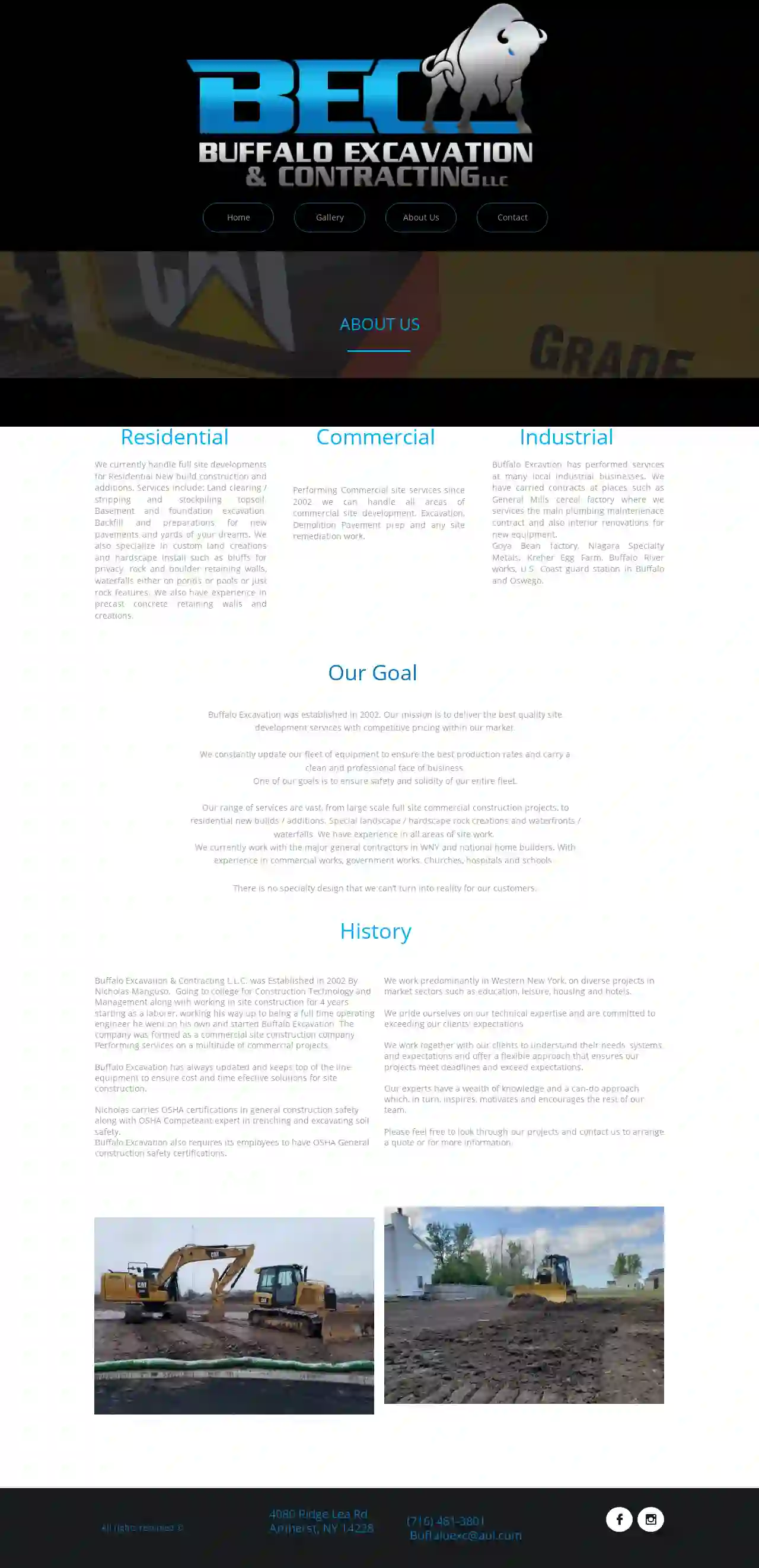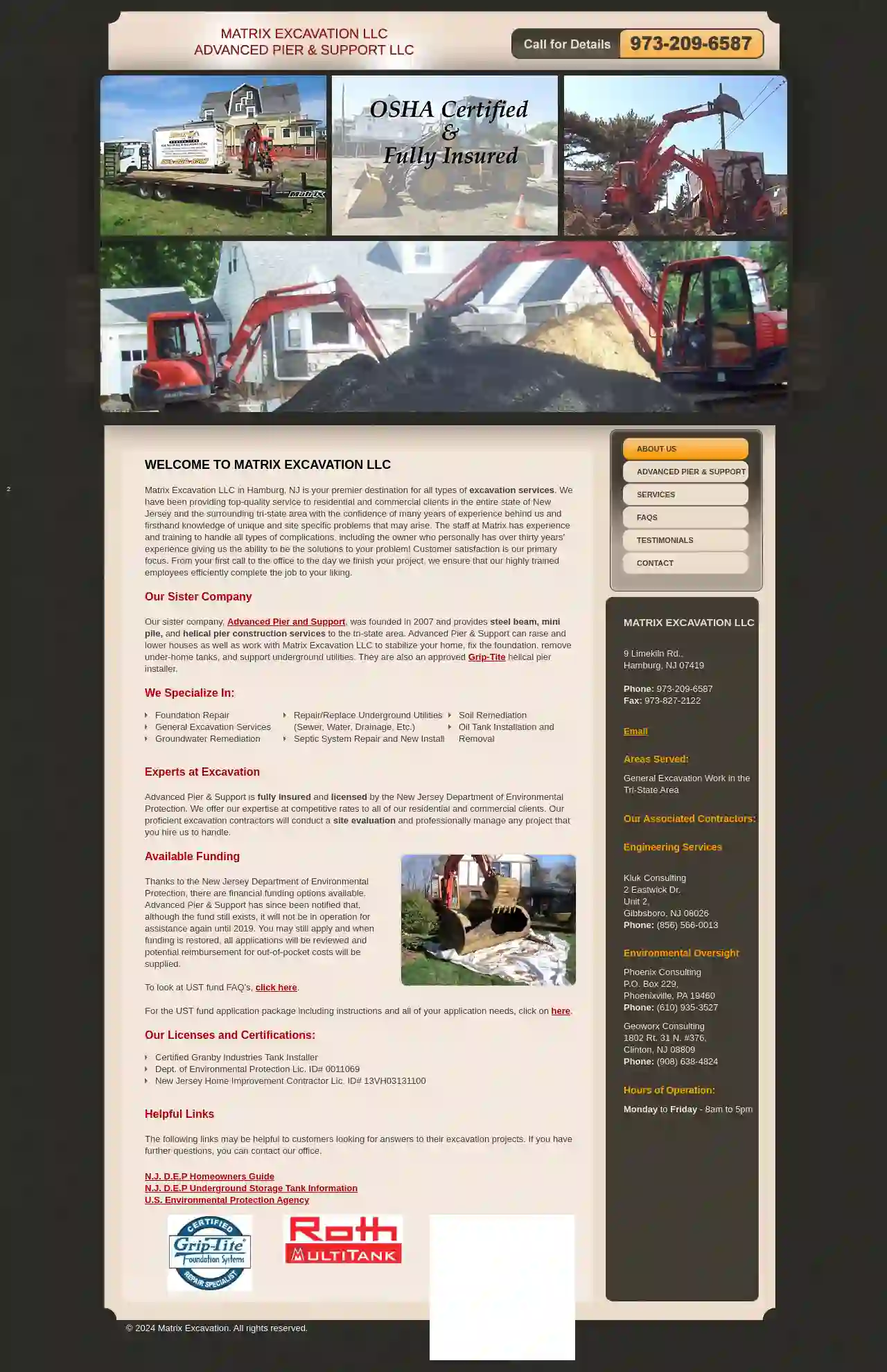Excavation Contractors Saugerties
Top Excavation Companies in Saugerties
Get multiple Excavation Company Near Me quotes for your project today! Compare profiles, reviews, accreditations, portfolio, etc... and choose the best offer.

LONG ISLAND EXCAVATION
240 Elwood Road, East Northport, 11731, USBongiorno's Contracting Professional groundwork and excavation service from one of the leading construction excavation companies in New York. There is a lot more to groundwork than just moving earth. Our extensive experience ensures that all concerns and laws relating to the environment, civil engineering and health and safety are taken into account to give you peace of mind. Reasons for Choosing Our Company Established 70 years in business on Long Island Licensed and Insured Home Improvement Contractors No Sub-Contracting, All the work is done by our team Many Recent Job References Family Owned and Operated Using only quality materials Forms of Payments Excepted: Credit Cards (VISA, Mastercard, American Express, Discover), Personal checks, Cashier Checks. Suffolk County Home Improvement License 9615-H Our Team (Left to Right) Charles F. Bongiorno 111 - Charles F. Bongiorno Jr. - Charles F. Bongiorno Sr. Corporate Office Chuck Bongiorno As. Bs. Ms. 240 Elwood Road East Northport, New York 11731 Business Phone: (631) 368-9086 Cell Phone: (631) 848-3190 Yard: (631) 368-8123 Email: [email protected]
- Services
- Why Us?
- Our Team
- Gallery
Get Quote
Lehigh Construction Group, Inc.
4.26 reviews4327 S Taylor Road, Orchard Park, 14127, USProviding a full array of Construction, Maintenance and Repair Services to meet Client Construction Needs. A trusted commercial general contractor for Buffalo and WNY delivering construction services with two mainstay principles in mind: WORK HARD and TREAT PEOPLE RIGHT. Our team lives by these principles as we strive to deliver the best customer experience - safely & on-time. Smarter Solutions Providing clients with customized construction building services & emphasizing speed-to-market in an environment of trust, collaboration, and transparency for 40 years. Lehigh Project Building Repairs & Maintenance Lehigh PRO service vans are equipped to handle any small construction job. Lehigh PRO performs thousands of building repairs and facility maintenance jobs as one of Buffalo's trusted building repair and facility maintenance providers. Lehigh Pro Emergency Repairs Lehigh PRO emergency repair services provide quick-response maintenance & repair options. As general contractors, PRO crews take steps to ensure work is completed in a safe and timely manner. Lehigh Industrial Services Industrial Plant Small Construction The Lehigh Industrial Services team is fully equipped to handle any plant construction job and our industrial experience with concrete, steel & metal, masonry and sitework sets us apart. Customers include industrial manufacturing plants, chemical, pharmaceutical, agri-business and warehouse & distribution. Get to Know Lehigh Safety Safety is a Lehigh Core Value. Our philosophy remains unchanged – send everyone home safely to their family every day. We remain on the cutting edge of construction industry safety standards and practices by maintaining our commitment to training and educating employees so they perform in the safest manner possible. History Lehigh Construction Group, Inc. was founded in 1984 by Dave Knauss and Tom Glomb as commercial general contractors for Buffalo and Western New York businesses. Over 40 years later we have grown into one of Buffalo’s most trusted commercial general contractors, offering a full array of commercial construction services. From small scale building maintenance repairs to new-builds & plant additions, Lehigh provides expertise in all aspects of construction. Let us be your commercial general contractor.
- Services
- Why Us?
- Gallery
Get Quote
RPS Excavating
518 reviews10000 County Rd 12, Seaforth, N0L 1P0, USAbout RPS Excavating RPS Excavating is a family-owned and operated business with over 20 years of experience in the excavating industry. We are committed to providing our clients with high-quality services at competitive prices. We specialize in a wide range of excavating services, including: Site preparation Grading Demolition Utility installation Drainage And more! We are fully licensed and insured, and we have a team of experienced and qualified professionals who are dedicated to providing our clients with the best possible service. We are committed to safety and environmental responsibility, and we always strive to exceed our clients' expectations. Contact us today for a free estimate!
- Services
- Why Us?
Get Quote
Apex Excavating & Construction Services, LLC
517 reviewsClay, USWelcome to Apex Excavating & Construction Services, LLC We are a team of experienced professionals committed to delivering top-quality services to our clients. Our company specializes in excavation, site preparation, and construction services in Greensboro & The Piedmont. We hold an unlimited general contractors license, so we can work on any project, no matter the size and scope. If you want to build ANYTHING, we can help. We may have started in site development, but our customers kept asking if we could build their driveway or help stand up a shed in their yard. So we added construction services to our offerings. We started small and as we grow, we strive to maintain our small company feel. By strategically partnering with skilled tradesmen in North Carolina, we maintain the flexibility of a small business, while being able to scale to meet the demands of big projects. Our mission is simple: To provide our customers with exceptional service, quality workmanship, and a smooth construction experience from start to finish. Whether you’re a homeowner, business owner, or contractor, we are committed to delivering outstanding value and exceeding your expectations in everything we do. We’re Apex Excavating & Construction Services, a family owned and locally operated construction and site development company in Greensboro, NC. We’ve been tearing up the ground and building things in the Piedmont for years, and we’re proud to be a part of the community. We’re committed to providing our customers with the highest quality services at a fair price. We’re also committed to safety, and we take every precaution to ensure that our employees and customers are safe on the job site.
- Services
- Why Us?
- Gallery
Get Quote
Site Right Excavation, LLC
123 Main Street, Anytown, 12345, USSite Right Excavation: Your Trusted Partner for Excavation Services Site Right Excavation is a family-owned and operated business with over 20 years of experience in the excavation industry. We are committed to providing our clients with high-quality, reliable, and affordable excavation services. Our team of experienced professionals is dedicated to exceeding your expectations and delivering exceptional results. We understand that every project is unique, and we take the time to listen to your needs and develop a customized plan that meets your specific requirements. Whether you need site preparation, foundation excavation, utility installation, or any other excavation service, we have the expertise and equipment to get the job done right. At Site Right Excavation, we are committed to safety and environmental responsibility. We use the latest technology and equipment to ensure that our projects are completed safely and efficiently. We also strive to minimize our environmental impact by using sustainable practices and recycling materials whenever possible. Contact us today to schedule a free consultation and learn more about how we can help you with your next excavation project.
- Services
- Why Us?
- Testimonials
Get Quote
Yankels Demolition
3.713 reviews341A Wallabout St, Brooklyn, 11206, USGold Standard in Demolition and Waste Management We are a licensed, bonded and insured company headquartered in Brooklyn, and serving the Tri State area. Yankel’s received a Buildzoom score of 104, placing us in the top 10th percentile of nearly 80,000 contractors nationwide. Look us up on Buildzoom.com under Atweek, Inc. Also read about us in our recent feature article in the Business Talk section of AMI Magazine. Where we Started YANKEL’S was founded in 1999 by Yehoshua Werzberger with only a small Ford Pick-up truck and a big vision. The Pick-up has since been replaced with an impressive fleet of trucks and mobile machinery; the big vision is still here, as is the personal touch. Having done all the leg work as he started and grew his business, Yehoshua has intimate knowledge of the work involved in every division of the company. Now at the helm of a full- service corporation and running one of the largest waste management facilities in the New York region, Yehoshua is still actively involved in every project. Why Choose Us We hold our customers in the highest regard, and their satisfaction drives every decision we make. Expect personalized attention, responsive communication, and a team that goes the extra mile to understand and fulfill your needs. Highly skilled and experienced professionals who are experts in their field. From project planning to execution, our team’s knowledge and expertise ensures a safe and successful demolition, meeting all necessary regulations and standards. We recognize the importance of delivering prompt results. With an unwavering commitment to efficiency, we execute every demolition with precision and speed, allowing you to move forward with your plans quickly and confidently. Reliability is the cornerstone of our reputation. Count on us to be there when you need us, delivering consistent and dependable services that you can trust. Our experience speaks for itself, and we aim to exceed your expectations every step of the way.
- Services
- Why Us?
- Testimonials
- Gallery
Get Quote
My Tractor Guy Grading & Excavation
517 reviewsClay, USGravel Grading & Delivery Whether you require repairs for your existing gravel driveway, road, or parking area, or you're in need of a brand-new installation, we have the expertise to meet your needs. Our team is well-equipped to tackle gravel driveway repairs, road maintenance, and the construction of new gravel surfaces. With attention to detail and quality materials, we ensure that your gravel surface is durable, functional, and aesthetically pleasing. Count on us to deliver reliable and professional gravel driveway, road, and parking area solutions that meet your specific requirements. Site Development Our Site Development services encompass a wide range of solutions to meet your needs. From culvert pipe installation to the creation and repair of ditches and swales, we ensure efficient water management on your property. Our expertise extends to the installation and repair of French drains, effectively mitigating water issues. Additionally, we offer building pad installation, leveling, slope correction, and soil stabilization services, ensuring a solid foundation for your construction projects. Count on us for comprehensive and reliable site development services tailored to your specific requirements. Land Clearing With our comprehensive land clearing services, we offer efficient and reliable solutions for your lot or acreage. Whether you need to clear trees, remove stumps, eliminate brush and debris, or perform brush cutting, we have you covered. Our experienced team utilizes advanced equipment and techniques to ensure thorough and precise clearing, leaving your land ready for the next phase of your project. From small lots to expansive acreage, we are equipped to handle projects of any size. Trust us to deliver professional and top-quality land clearing services tailored to your specific needs.
- Services
- Why Us?
- Testimonials
- Gallery
Get Quote
AAL Construction Services
123 Main Street, Anytown, 12345, USAbout AAL Construction Services AAL Construction Services is a family-owned and operated business with over 20 years of experience in the construction industry. We are committed to providing our clients with high-quality workmanship, competitive pricing, and exceptional customer service. We specialize in a wide range of construction services, including new home construction, renovations, additions, and commercial projects. Our team of experienced professionals is dedicated to exceeding your expectations and delivering projects on time and within budget. We understand that building or renovating your home is a significant investment, and we are here to guide you through every step of the process. From the initial design phase to the final walkthrough, we will work closely with you to ensure that your vision is realized. We are proud of our reputation for integrity, reliability, and customer satisfaction. We are committed to building lasting relationships with our clients and providing them with the peace of mind that comes with knowing that their project is in good hands.
- Services
- Why Us?
- Testimonials
Get Quote
Buffalo Excavation Services
4080 Ridge Lea Rd, Amherst, 14228, USAbout Us Buffalo Excavation was established in 2002. Our mission is to deliver the best quality site development services with competitive pricing within our market. We constantly update our fleet of equipment to ensure the best production rates and carry a clean and professional face of business. One of our goals is to ensure safety and solidity of our entire fleet. Our Services Our range of services are vast, from large scale full site commercial construction projects, to residential new builds / additions. Special landscape / hardscape rock creations and waterfronts / waterfalls. We have experience in all areas of site work. We currently work with the major general contractors in WNY and national home builders. With experience in commercial works, government works, Churches, hospitals and schools. There is no specialty design that we can’t turn into reality for our customers. History Buffalo Excavation & Contracting L.L.C. was Established in 2002 By Nicholas Manguso. Going to college for Construction Technology and Management along with working in site construction for 4 years starting as a laborer, working his way up to being a full time operating engineer he went on his own and started Buffalo Excavation. The company was formed as a commercial site construction company and has grown to include residential, industrial and government projects.
- Services
- Why Us?
- Gallery
Get Quote
Matrix Excavation LLC
55 reviews9 Limekiln Rd., Hamburg, 07419, USMatrix Excavation LLC: Your Trusted Excavation Partner in New Jersey Matrix Excavation LLC, based in Hamburg, NJ, is your go-to source for all your excavation needs. We've been serving both residential and commercial clients across New Jersey and the tri-state area for years, building a reputation for top-notch service and expertise. Our team boasts extensive experience and training, including our owner, who brings over 30 years of experience to the table. We understand the unique challenges that come with excavation projects and are equipped to handle any complications that may arise. At Matrix, customer satisfaction is our top priority. From your initial call to the completion of your project, we ensure our highly skilled team delivers efficient and high-quality work that meets your expectations. Our Sister Company: Advanced Pier & Support Advanced Pier & Support, our sister company established in 2007, specializes in steel beam, mini pile, and helical pier construction services throughout the tri-state area. They can raise and lower houses, collaborate with Matrix Excavation LLC to stabilize your home, address foundation issues, remove under-home tanks, and support underground utilities. Advanced Pier & Support is also an approved Grip-Tite helical pier installer. Expertise and Funding Options Advanced Pier & Support is fully insured and licensed by the New Jersey Department of Environmental Protection. We offer our services at competitive rates to all our clients. Our skilled excavation contractors will conduct a thorough site evaluation and professionally manage every project you entrust to us. Thanks to the New Jersey Department of Environmental Protection, financial funding options are available for certain projects. While the fund is currently not accepting applications, you can still apply and be considered for reimbursement when funding is restored.
- Services
- Why Us?
- Testimonials
- Gallery
Get Quote
Over 22,076+ Excavation Businesses on our directory
Our excavation companies operate in Saugerties & surroundings!
ExcavationHQ has curated and vetted the Best Excavation Contractors in Saugerties. Find a top & trustworthy contractor today.
Frequently Asked Questions About Excavation Contractors
- Spring and Fall: Often considered favorable due to moderate temperatures and drier soil conditions.
- Summer: Can be suitable, but hot weather can make working conditions challenging and might require additional measures (shade, hydration) for workers.
- Winter: Excavation in winter can be more difficult due to frozen ground, snow, and potential delays caused by inclement weather. It might also require specialized equipment or techniques.
- Excavations Deeper Than a Certain Depth: This varies by jurisdiction, usually around 5 feet.
- Excavations Near Utilities: Digging near buried utilities (gas, water, electric) often requires permits and utility locates to prevent damage.
- Excavations Affecting Public Property: Projects impacting sidewalks, roads, or other public areas typically require permits.
- Excavations in Environmentally Sensitive Areas: Projects in wetlands, floodplains, or other sensitive areas might need special permits.
- Utility Locates: Contact your utility companies to mark the locations of underground lines before excavation begins. This is usually a free service.
- Hand Digging: Excavate carefully by hand near marked utility lines to avoid damage.
- Potholing: Digging small test holes to expose and verify utility depths and locations.
- Safe Distances: Maintaining a safe distance between excavation equipment and marked utility lines.
- Vacuum Excavation: Using vacuum excavation techniques to expose utilities without digging, reducing the risk of damage.
- New Construction: Laying foundations, basements, or underground utilities for new buildings.
- Home Additions: Creating space for new rooms, basements, or extensions.
- Landscaping: Leveling ground, creating slopes, installing retaining walls, or digging for ponds or pools.
- Drainage Improvement: Installing French drains, drainage ditches, or swales to manage water runoff.
- Utility Installation or Repair: Laying new water, sewer, gas, or electrical lines, or repairing existing ones.
- Demolition: Clearing debris and preparing the site after demolishing a structure.
What is the best time of year for excavation?
Do I need a permit for excavation?
How do you protect utilities during excavation?
How do I know if I need excavation for my project?
What is the best time of year for excavation?
- Spring and Fall: Often considered favorable due to moderate temperatures and drier soil conditions.
- Summer: Can be suitable, but hot weather can make working conditions challenging and might require additional measures (shade, hydration) for workers.
- Winter: Excavation in winter can be more difficult due to frozen ground, snow, and potential delays caused by inclement weather. It might also require specialized equipment or techniques.
Do I need a permit for excavation?
- Excavations Deeper Than a Certain Depth: This varies by jurisdiction, usually around 5 feet.
- Excavations Near Utilities: Digging near buried utilities (gas, water, electric) often requires permits and utility locates to prevent damage.
- Excavations Affecting Public Property: Projects impacting sidewalks, roads, or other public areas typically require permits.
- Excavations in Environmentally Sensitive Areas: Projects in wetlands, floodplains, or other sensitive areas might need special permits.
How do you protect utilities during excavation?
- Utility Locates: Contact your utility companies to mark the locations of underground lines before excavation begins. This is usually a free service.
- Hand Digging: Excavate carefully by hand near marked utility lines to avoid damage.
- Potholing: Digging small test holes to expose and verify utility depths and locations.
- Safe Distances: Maintaining a safe distance between excavation equipment and marked utility lines.
- Vacuum Excavation: Using vacuum excavation techniques to expose utilities without digging, reducing the risk of damage.
How do I know if I need excavation for my project?
- New Construction: Laying foundations, basements, or underground utilities for new buildings.
- Home Additions: Creating space for new rooms, basements, or extensions.
- Landscaping: Leveling ground, creating slopes, installing retaining walls, or digging for ponds or pools.
- Drainage Improvement: Installing French drains, drainage ditches, or swales to manage water runoff.
- Utility Installation or Repair: Laying new water, sewer, gas, or electrical lines, or repairing existing ones.
- Demolition: Clearing debris and preparing the site after demolishing a structure.